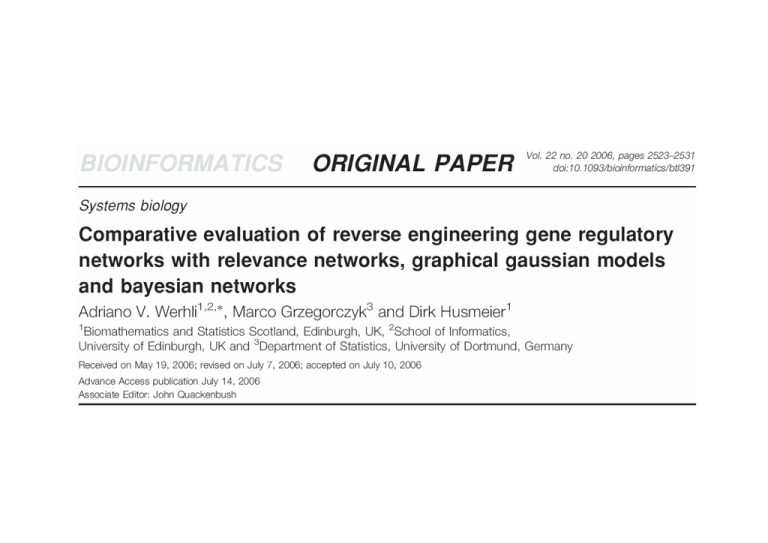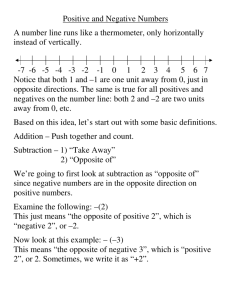Document 13354417
advertisement

unknown E.g.: Flow cytometry experiments data data machine learning statistical methods Reverse Engineering of Regulatory Networks • Can we learn the network structure from postgenomic data themselves? • Statistical methods to distinguish between – Direct interactions – Indirect interactions • Challenge: Distinguish between – Correlations – Causal interactions • Breaking symmetries with active interventions: – Gene knockouts (VIGs, RNAi) direct common interaction indirect regulator interaction co-regulation • Relevance networks • Graphical Gaussian models • Bayesian networks Disadvantage of relevance networks Cannot distinguish between direct and indirect interactions Bayesian networks versus Graphical Gaussian models Directed versus undirected graphs Score based versus constrained based inference Biology •Protein signal transduction pathway •Measuring protein concentrations with flow cytometry •Active interventions Example: Protein signalling pathway Cell membran phosphorylation nucleus TF TF -> cell response Raf signalling pathway Receptor molecules Cell membrane Activation Interaction in signalling pathway Phosphorylated protein Inhibition From Sachs et al Science 2005 Flow cytometry data • Intracellular multicolour flow cytometry experiments: concentrations of 11 proteins • 5400 cells have been measured under 9 different cellular conditions (cues) • Downsampling to 100 instances (5 separate subsets): indicative of microarray experiments How do we assess the network reconstruction accuracy ? • Real data Æ no gold standard • Synthetic data Æ gold standard Assessing the network reconstruction accuracy Extracted network True network Evaluation of performance Biological knowledge (gold standard network) Assessing the network reconstruction accuracy Extracted network True network Evaluation of performance Biological knowledge (gold standard network) Feasible for synthetic data Assessing the network reconstruction accuracy Extracted network True network Evaluation of performance Biological knowledge (gold standard network) Real data: take knowledge from the literature as a “bronze standard” Evaluation • On real experimental data, using the gold standard network from the literature • On synthetic data simulated from the goldstandard network Evaluation • On real experimental data, using the gold standard network from the literature • On synthetic data simulated from the goldstandard network Evaluation: Raf signalling pathway • Cellular signalling network of 11 phosphorylated proteins and phospholipids in human immune systems cell • Deregulation Æ carcinogenesis • Extensively studied in the literature Æ gold standard network Raf signalling pathway Receptor molecules Cell membrane Activation Interaction in signalling pathway Phosphorylated protein Inhibition From Sachs et al Science 2005 Data • Intracellular multicolour flow cytometry experiments concentrations of 11 proteins • 5400 cells have been measured under 9 different cellular conditions (cues) • We decided to downsample our test data sets to 100 instances - indicative of microarray experiments Two types of experiments Raf signalling pathway Receptor molecules Cell membrane Activation Interaction in signalling pathway Phosphorylated protein Inhibition From Sachs et al Science 2005 Evaluation • On real experimental data, using the gold standard network from the literature • On synthetic data simulated from the goldstandard network Comparison with simulated data Raf pathway How do we measure the performance ? • AUROC versus TPFP5 • DGE versus UGE From Perry Sprawls True positives (TP) = ? False positives (FP) = ? False negatives (FN) = ? True negatives (TN) = ? Sensitivity = TP/(TP+FN) = ? Specificity = TN/(TN+FP) = ? True positives (TP) = 1 False positives (FP) = 1 False negatives (FN) = ? True negatives (TN) = ? Sensitivity = TP/(TP+FN) = ? Specificity = TN/(TN+FP) = ? True positives (TP) = 1 False positives (FP) = 1 False negatives (FN) = 1 True negatives (TN) = ? Sensitivity = TP/(TP+FN) = ? Specificity = TN/(TN+FP) = ? True positives (TP) = 1 False positives (FP) = 1 False negatives (FN) = 1 True negatives (TN) = 3 Sensitivity = TP/(TP+FN) = ? Specificity = TN/(TN+FP) = ? True positives (TP) = 1 False positives (FP) = 1 False negatives (FN) = 1 True negatives (TN) = 3 Sensitivity = TP/(TP+FN) = 0.5 Specificity = TN/(TN+FP) = 0.75 From Perry Sprawls AUC: area under the curve. AUC = 1: perfect prediction AUC = 0.5: random expectation From Perry Sprawls Directed graph evaluation (DGE) Undirected edge = superposition of two directed edges Undirected graph evaluation (UGE) AUC: area under the curve TPFP5: Sensitivity for 95% specificity From Perry Sprawls Synthetic data, observations Synthetic data, interventions Cytometry data, observations Cytometry data, interventions Conclusions 1 • BNs and GGMs outperform RNs, most notably on Gaussian data. • No significant difference between BNs and GGMs on observational data. • For interventional data, BNs clearly outperform GGMs and RNs, especially when taking the edge direction (DGE score) rather than just the skeleton (UGE score) into account. Conclusions 2 • Performance on synthetic data better than on real data. • Real data: more complex • Real interventions are not ideal • Errors in the gold-standard network Disputed structure of the goldstandard network Regulation of Raf-1 by Direct Feedback Phosphorylation. Molecular Cell, Vol. 17, 2005 Dougherty et al




